Exploring Energy Security and Independence for Small Energy Users: A Latvian Case Study on Unleashing Stirling Engine Potential
Abstract
1. Introduction
1.1. Definition and Importance of Energy Security
1.2. Existing Problems with Energy Supply in the European Union
1.3. Choice of Energy Supply Technologies
1.3.1. Biomass Boilers
1.3.2. Stiling Engine
1.3.3. Solar Energy Systems
1.3.4. Heat Pumps
1.3.5. Hybrid Systems
1.4. Research Gap
1.5. Main Objective
1.6. Hypothesis
2. Materials and Methods
2.1. Research Method
2.2. Parameters and Values Used in This Study for Calculation
2.3. Equations Used
| Specific Energy Cost for Baseline Scenario (Scenario 0), EUR/MWh | |
| Total Energy Cost, EUR | |
| Annual Electricity Consumption, MWh | |
| Annual Thermal Energy Consumption, MWh | |
| Electricity Tariff, EUR/MWh | |
| Efficiency of the Natural Gas Boiler, % | |
| Specific Cost of Natural Gas, EUR/MWh |
| Specific Energy Cost for Alternative Scenarios, EUR/MWh | |
| Fuel Consumption in Energy Equivalence, MWh | |
| Specific Cost of Fuel, EUR/MWh | |
| Excess Electricity Produced, MWh | |
| Specific Cost of Electricity (sell), EUR/MWh |
| Total Investments, EUR | |
| Capacity Required, kW | |
| Specific Cost of Technology, EUR/kW |
| Payback Period, year |
| Annual Amount of Emissions, g (for CO2–kg) | |
| Emission Factor (see Figure 3), g/MWh |
3. Analysis of Input Data for Defining Scenarios for Case Study
3.1. General Description of the Existing Situation
3.2. Thermal Energy (Q) Consumption
3.3. Electricity (E) Consumption
3.4. Development Scenarios
3.4.1. Baseline Scenario (BS)
3.4.2. Biomass + SE (S1)
3.4.3. Solar PV + HP (S2)
3.4.4. Solar Collectors + TES (S3)
4. Analysis of Output Data and Scenario’s Simulation Results
4.1. Reduction of Thermal Energy and Electricity Consumption
4.1.1. Thermal Energy (Q) Consumption
4.1.2. Electricity (E) Consumption
4.1.3. Energy Reduction Possibilities
4.2. Assessment of Scenarios
- by load (baseline or existing load and reduced load (based on established benchmarks);
- by energy technology used (natural gas, Stirling engine, solar PV + heat pump, solar collectors + thermal energy storage).
4.3. Specific Energy Cost
4.4. Total Investments
4.5. Payback Period
4.6. Enviermental Impact
4.6.1. Emission Factors
4.6.2. Total Amount of Emissions
5. Discussion
6. Conclusions
- Scenario S1, where biomass boiler and Stirling engine are expected, is characterized by lower investments and a shorter payback period;
- Scenarios S2 and S3, where also solar technologies are expected, have lower specific energy costs and amount of emissions;
- Increasing energy security involves technological, economic, and environmental aspects;
- Creating a sustainable energy supply system, it is essential to consider all the criteria addressed in this study.
Author Contributions
Funding
Institutional Review Board Statement
Informed Consent Statement
Data Availability Statement
Conflicts of Interest
References
- International Energy Agency. Emergency Response and Energy Security: Ensuring the Uninterrupted Availability of Energy Sources at an Affordable Price. 2023. Available online: https://www.iea.org/about/emergency-response-and-energy-security (accessed on 28 November 2023).
- Cherp, A.; Jewell, J. The concept of energy security: Beyond the four As. Energy Policy 2014, 75, 415–421. [Google Scholar] [CrossRef]
- Jakstas, T. What does energy security mean? In Energy Transformation Towards Sustainability; Elsevier: Amsterdam, The Netherlands, 2020; pp. 99–112. [Google Scholar] [CrossRef]
- Kruyt, B.; van Vuuren, D.P.; de Vries, H.J.M.; Groenenberg, H. Indicators for energy security. Energy Policy 2009, 37, 2166–2181. [Google Scholar] [CrossRef]
- Indriyanto, A.R.; T Wattimena, B.A.; Batih, H.; Sari, I. Energy Security and Sustainable Development. 2013. Available online: https://iiee.or.id/wp-content/uploads/2015/07/ESSD-Energy-Security-and-Sustainable-Development.pdf (accessed on 28 November 2023).
- Sai, R.; Furubayashi, T.; Nakata, T. Preliminary study of energy security and energy resilience evaluation in Japan. Trans. JSME 2017, 83, 16-00161. (In Japanese) [Google Scholar] [CrossRef][Green Version]
- Intharak, N.; Julay, J.H.; Nakanishi, S.; Matsumoto, T.; Mat Sahid, E.J.; Ormeno Aquino, A.G.; Aponte, A.A. A Quest for Energy Security in the 21st Century: Resources and Constraints; Asia Pacific Energy Research Centre, Institute of Energy Economics: Tokyo, Japan, 2007; Available online: https://aperc.or.jp/file/2010/9/26/APERC_2007_A_Quest_for_Energy_Security.pdf (accessed on 28 November 2023).
- Sustainable Development. In Lees’ Loss Prevention in the Process Industries; Butterworth-Heinemann: Oxford, UK, 2012; pp. 2507–2521. [CrossRef]
- Gautam, P.; Kumar, S.; Lokhandwala, S. Energy-Aware Intelligence in Megacities. In Current Developments in Biotechnology and Bioengineering: Waste Treatment Processes for Energy Generation; Elsevier: Amsterdam, The Netherlands, 2019; pp. 211–238. [Google Scholar] [CrossRef]
- Minelli, F. Achieving Energy Security and Environmental Sustainable Development. 2017. Available online: http://www.nytimes.com/2016/10/13/world/as (accessed on 28 November 2023).
- Luty, L.; Zioło, M.; Knapik, W.; Bąk, I.; Kukuła, K. Energy Security in Light of Sustainable Development Goals. Energies 2023, 16, 1390. [Google Scholar] [CrossRef]
- Strojny, J.; Krakowiak-Bal, A.; Knaga, J.; Kacorzyk, P. Energy Security: A Conceptual Overview. Energies 2023, 16, 5042. [Google Scholar] [CrossRef]
- Novikau, A. Conceptualizing and Redefining Energy Security: A Comprehensive Review. In China’s Energy Security: Analysis, Assessment and Improvement; World Scientific: Singapore, 2020. [Google Scholar] [CrossRef]
- The politics of energy security. Nat. Energy 2023, 8, 1047. [CrossRef]
- Šprajc, P.; Bjegović, M.; Vasić, B. Energy security in decision making and governance—Methodological analysis of energy trilemma index. Renew. Sustain. Energy Rev. 2019, 114, 109341. [Google Scholar] [CrossRef]
- IEA. Mission: The IEA Works with Governments and Industry to Shape a Secure and Sustainable Energy Future for All. 2023. Available online: https://www.iea.org/about/mission (accessed on 3 January 2024).
- Urbano, E.M.; Kampouropoulos, K.; Romeral, L. Energy Crisis in Europe: The European Union’s Objectives and Countries’ Policy Trends—New Transition Paths? Energies 2023, 16, 5957. [Google Scholar] [CrossRef]
- Parag, Y.; Fawcett, T.; Hampton, S.; Eyre, N. Energy saving in a hurry: A research agenda and guidelines to study European responses to the 2022–2023 energy crisis. Energy Res. Soc. Sci. 2023, 97, 102999. [Google Scholar] [CrossRef]
- Fazelianov, E.M. The Energy Crisis in Europe and Russian Gas Supplies. Her. Russ. Acad. Sci. 2022, 92, S902–S907. [Google Scholar] [CrossRef]
- Elbassoussy, A. European energy security dilemma: Major challenges and confrontation strategies. Rev. Econ. Political Sci. 2019, 4, 321–343. [Google Scholar] [CrossRef]
- Amblard, L.; Carter, C. Implementing environmental Europe: Non-linearity, nature and institutions. Environ. Sci. Policy 2022, 136, 442–446. [Google Scholar] [CrossRef]
- Umbach, F. Global energy security and the implications for the EU. Energy Policy 2010, 38, 1229–1240. [Google Scholar] [CrossRef]
- Kielin, J. Problems and challenges in the EU sustainable consumption and production action plan. Int. J. Public Law Policy 2013, 3, 276–286. [Google Scholar] [CrossRef]
- Jonsson, D.K.; Johansson, B.; Månsson, A.; Nilsson, L.J.; Nilsson, M.; Sonnsjö, H. Energy security matters in the EU Energy Roadmap. Energy Strategy Rev. 2015, 6, 48–56. [Google Scholar] [CrossRef]
- Fabra, N. Reforming European electricity markets: Lessons from the energy crisis. Energy Econ. 2023, 126, 106963. [Google Scholar] [CrossRef]
- Liu, Y.; Xie, X.; Wang, M. Energy structure and carbon emission: Analysis against the background of the current energy crisis in the EU. Energy 2023, 280, 128129. [Google Scholar] [CrossRef]
- Mišík, M. The EU needs to improve its external energy security. Energy Policy 2022, 165, 112930. [Google Scholar] [CrossRef]
- Eurostat. Energy Statistics—An Overview. 2023. Available online: https://ec.europa.eu/eurostat/statistics-explained/index.php?title=Energy_statistics_-_an_overview (accessed on 28 November 2023).
- Carfora, A.; Pansini, R.V.; Scandurra, G. Energy dependence, renewable energy generation and import demand: Are EU countries resilient? Renew. Energy 2022, 195, 1262–1274. [Google Scholar] [CrossRef]
- Camprubí, L. Whose self-sufficiency? Energy dependency in Spain from 1939. Energy Policy 2019, 125, 227–234. [Google Scholar] [CrossRef]
- Lund, H.; Hvelplund, F.; Kass, I.; Dukalskis, E.; Blumberga, D. District heating and market economy in Latvia. Energy 1999, 24, 549–559. [Google Scholar] [CrossRef]
- De Rosa, M.; Gainsford, K.; Pallonetto, F.; Finn, D.P. Diversification, concentration and renewability of the energy supply in the European Union. Energy 2022, 253, 124097. [Google Scholar] [CrossRef]
- Damen, M. Four Challenges of the Energy Crisis for the EU’s Strategic Autonomy. 2023. Available online: https://www.europarl.europa.eu/RegData/etudes/BRIE/2023/747099/EPRS_BRI(2023)747099_EN.pdf (accessed on 28 November 2023).
- Litră, A.V.; Nichifor, E.; Chiţu, I.B.; Zamfirache, A.; Brătucu, G. The Dilemma of the European Integration Principle—Ensuring Energy Independence of the European Union. Sustainability 2023, 15, 15560. [Google Scholar] [CrossRef]
- Ningi, T.; Taruvinga, A.; Zhou, L. Determinants of energy security for rural households: The case of Melani and Hamburg communities, Eastern Cape, South Africa. Afr. Secur. Rev. 2020, 29, 299–315. [Google Scholar] [CrossRef]
- Neves, D.; Baptista, P.; Simões, M.; Silva, C.A.; Figueira, J.R. Designing a municipal sustainable energy strategy using multi-criteria decision analysis. J. Clean. Prod. 2018, 176, 251–260. [Google Scholar] [CrossRef]
- Esfahani, A.N.; Moghaddam, N.B.; Maleki, A.; Nazemi, A. The knowledge map of energy security. Energy Rep. 2021, 7, 3570–3589. [Google Scholar] [CrossRef]
- Hossain, Y.; Loring, P.A.; Marsik, T. Defining energy security in the rural North—Historical and contemporary perspectives from Alaska. Energy Res. Soc. Sci. 2016, 16, 89–97. [Google Scholar] [CrossRef]
- Martínez, D.M.; Ebenhack, B.W.; Wagner, T.P. Residential and commercial sector energy efficiency. In Energy Efficiency; Elsevier: Amsterdam, The Netherlands, 2019; pp. 227–269. [Google Scholar] [CrossRef]
- Kabalci, E.; Boyar, A.; Kabalci, Y. Centralized power generation. In Hybrid Renewable Energy Systems and Microgrids; Academic Press: Cambridge, MA, USA, 2021; pp. 47–72. [Google Scholar] [CrossRef]
- Asif, M. Sustainable energy transition in the 21st century. In Handbook of Energy and Environmental Security; Academic Press: Cambridge, MA, USA, 2022; pp. 27–38. [Google Scholar] [CrossRef]
- Sioshansi, F.P. Decentralized Energy: Is It as Imminent or Serious as Claimed? In Distributed Generation and its Implications for the Utility Industry; Academic Press: Cambridge, MA, USA, 2014; pp. 3–32. [Google Scholar] [CrossRef]
- Ahlqvist, V.; Holmberg, P.; Tangerås, T. A survey comparing centralized and decentralized electricity markets. Energy Strategy Rev. 2022, 40, 100812. [Google Scholar] [CrossRef]
- Nielsen, J.E.; Sørensen, P.A. Renewable district heating and cooling technologies with and without seasonal storage. In Renewable Heating and Cooling: Technologies and Applications; Woodhead Publishing: Cambridge, UK, 2016; pp. 197–220. [Google Scholar] [CrossRef]
- Jeremy, M. Distributed vs. Centralized Electricity Generation: Are We Witnessing a Change of Paradigm? 2009. Available online: https://www.vernimmen.net/ftp/An_introduction_to_distributed_generation.pdf (accessed on 28 November 2023).
- Kerfah, I.K.; El Hassar, S.M.K.; Rouleau, J.; Gosselin, L.; Larabi, A. Analysis of strategies to reduce thermal discomfort and natural gas consumption during heating season in Algerian residential dwellings. Int. J. Sustain. Build. Technol. Urban Dev. 2020, 11, 45–76. [Google Scholar] [CrossRef]
- Balode, L.; Dolge, K.; Blumberga, D. The contradictions between district and individual heating towards green deal targets. Sustainability 2021, 13, 3370. [Google Scholar] [CrossRef]
- Denholm, P.; Arent, D.J.; Baldwin, S.F.; Bilello, D.E.; Brinkman, G.L.; Cochran, J.M.; Cole, W.J.; Frew, B.; Gevorgian, V.; Heeter, J.; et al. The challenges of achieving a 100% renewable electricity system in the United States. Joule 2021, 5, 1331–1352. [Google Scholar] [CrossRef]
- Mauri, L.; Vallati, A.; Ocłoń, P. Low impact energy saving strategies for individual heating systems in a modern residential building: A case study in Rome. J. Clean. Prod. 2019, 214, 791–802. [Google Scholar] [CrossRef]
- McKenna, R. The double-edged sword of decentralized energy autonomy. Energy Policy 2018, 113, 747–750. [Google Scholar] [CrossRef]
- Habash, R. Building as an energy system. In Sustainability and Health in Intelligent Buildings; Woodhead Publishing: Cambridge, UK, 2022; pp. 59–94. [Google Scholar] [CrossRef]
- Kiehbadroudinezhad, M.; Merabet, A.; Hosseinzadeh-Bandbafha, H. Bioenergy Programs in North and South America and Canada. In Reference Module in Earth Systems and Environmental Sciences; Elsevier: Amsterdam, The Netherlands, 2023. [Google Scholar] [CrossRef]
- Kalogirou, S.A. Solar Thermal Systems: Components and Applications—Introduction. In Comprehensive Renewable Energy; Elsevier: Amsterdam, The Netherlands, 2012; pp. 1–25. [Google Scholar] [CrossRef]
- Gareiou, Z.; Drimili, E.; Zervas, E. Public acceptance of renewable energy sources. In Low Carbon Energy Technologies in Sustainable Energy Systems; Academic Press: Cambridge, MA, USA, 2021; pp. 309–327. [Google Scholar] [CrossRef]
- Neave, A. Heat pumps and their applications. In Plant Engineer’s Reference Book; Butterworth-Heinemann: Oxford, UK, 2002; pp. 41-1, 41-3–41-9. [Google Scholar] [CrossRef]
- Carroll, P.; Chesser, M.; Lyons, P. Air Source Heat Pumps field studies: A systematic literature review. Renew. Sustain. Energy Rev. 2020, 134, 110275. [Google Scholar] [CrossRef]
- Levine, A. Industrial waters. In Membranes for Industrial Wastewater Recovery and Re-Use; Elsevier: Amsterdam, The Netherlands, 2003; pp. 75–101. [Google Scholar] [CrossRef]
- Mandø, M. Direct combustion of biomass. In Biomass Combustion Science, Technology and Engineering; Woodhead Publishing: Cambridge, UK, 2013; pp. 61–83. [Google Scholar] [CrossRef]
- Lam, M.K.; Loy, A.C.M.; Yusup, S.; Lee, K.T. Biohydrogen Production From Algae. In Biomass, Biofuels, Biochemicals: Biohydrogen, 2nd ed.; Elsevier: Amsterdam, The Netherlands, 2019; pp. 219–245. [Google Scholar] [CrossRef]
- Saidur, R.; Abdelaziz, E.A.; Demirbas, A.; Hossain, M.S.; Mekhilef, S. A review on biomass as a fuel for boilers. Renew. Sustain. Energy Rev. 2011, 15, 2262–2289. [Google Scholar] [CrossRef]
- Basu, P. Chapter 3—Pyrolysis and Torrefaction. In Biomass Gasification and Pyrolysis; Basu, P., Ed.; Academic Press: Cambridge, MA, USA, 2010; pp. 65–96. [Google Scholar] [CrossRef]
- Basu, P. Chapter 5—Gasification Theory and Modeling of Gasifiers. In Biomass Gasification and Pyrolysis; Basu, P., Ed.; Academic Press: Cambridge, MA, USA, 2010; pp. 117–165. [Google Scholar] [CrossRef]
- George, J.; Palatel, A.; Chandrasekharan, M. Stoichiometric Equilibrium Model based Assessment of Hydrogen Generation through Biomass Gasification. Procedia Technol. 2016, 25, 982–989. [Google Scholar] [CrossRef]
- Nunes, L.J.R.; Godina, R.; Matias, J.C.O.; Catalão, J.P.S. Evaluation of the utilization of woodchips as fuel for industrial boilers. J. Clean. Prod. 2019, 223, 270–277. [Google Scholar] [CrossRef]
- Vigants, G.; Veidenbergs, I.; Vigants, E.; Blumberga, D. Cost Analysis of a Wood Chip Boiler House with a Gas Condenser. Energy Procedia 2015, 75, 1214–1220. [Google Scholar] [CrossRef][Green Version]
- Zhang, L.; Zhai, H.; He, J.; Yang, F.; Wang, S. Application of Exergy Analysis in Flue Gas Condensation Waste Heat Recovery System Evaluation. Energies 2022, 15, 7525. [Google Scholar] [CrossRef]
- Bălănescu, D.T.; Homutescu, V.M. Study on condensing boiler technology potential accounting various fuels. Procedia Manuf. 2019, 32, 504–512. [Google Scholar] [CrossRef]
- Priedniece, V.; Kirsanovs, V.; Dzikēvičs, M.; Vīgants, Ģ.; Veidenbergs, I.; Blumberga, D. Experimental and analytical study of the flue gas condenser—Fog unit. Energy Procedia 2019, 158, 822–827. [Google Scholar] [CrossRef]
- Blumberga, D.; Vigants, G.; Kirsanovs, V.; Veidenbergs, I.; Dzikevics, M. Fog unit versus electrical precipitator and filter. Energy Procedia 2017, 128, 400–405. [Google Scholar] [CrossRef]
- Cornette, J.F.P.; Coppieters, T.; Lepaumier, H.; Blondeau, J.; Bram, S. Particulate matter emission reduction in small- and medium-scale biomass boilers equipped with flue gas condensers: Field measurements. Biomass Bioenergy 2021, 148, 106056. [Google Scholar] [CrossRef]
- Alfarawi, S.; Webb-Martin, M.; Mahmoud, S.; Al-Dadah, R.K. Thermal analysis of stirling engine to power automotive alternator using heat from exhaust gases. Energy Procedia 2014, 61, 2395–2398. [Google Scholar] [CrossRef]
- Uzuneanu, K.; Scarpete, D.; Kamburova, V. An Assessment of Commercial Stirling Engines for Tri-Generation Systems. Termotehnica 2016, 1, 56–59. [Google Scholar]
- Shih, H.J. An analysis model combining gamma-type stirling engine and power converter. Energies 2019, 12, 1322. [Google Scholar] [CrossRef]
- Zhu, S.; Yu, G.; Liang, K.; Dai, W.; Luo, E. A review of Stirling-engine-based combined heat and power technology. Appl. Energy 2021, 294, 116965. [Google Scholar] [CrossRef]
- Nagaoka, Y.; Nakamura, M.; Yamashita, K.; Ito, Y.; Haramura, S.; Yamaguchi, K. Development of Stirling Engine Heat Pump. In Heat Pumps; Pergamon: Oxford, UK, 1990; pp. 595–603. [Google Scholar] [CrossRef]
- Raju, E.S.N.; Jain, T. Distributed energy resources and control. In Distributed Energy Resources in Microgrids: Integration, Challenges and Optimization; Academic Press: Cambridge, MA, USA, 2019; pp. 33–56. [Google Scholar] [CrossRef]
- Abuelyamen, A.; Ben-Mansour, R. Energy efficiency comparison of Stirling engine types (α, β, and γ) using detailed CFD modeling. Int. J. Therm. Sci. 2018, 132, 411–423. [Google Scholar] [CrossRef]
- Kubule, A.; Kramens, J.; Bimbere, M.; Pedišius, N.; Blumberga, D. Trends for Stirling Engines in Households: A Systematic Literature Review. Energies 2024, 17, 383. [Google Scholar] [CrossRef]
- Ashok Kumar, L.; Indragandhi, V.; Uma Maheswari, Y. PVSYST. In Software Tools for the Simulation of Electrical Systems; Academic Press: Cambridge, MA, USA, 2020; pp. 349–392. [Google Scholar] [CrossRef]
- Khanafer, K.; Vafai, K. Applications of Nanomaterials in Solar Energy and Desalination Sectors. In Advances in Heat Transfer; Elsevier: Amsterdam, The Netherlands, 2013; Volume 45, pp. 303–329. [Google Scholar] [CrossRef]
- Bhatia, S.C. Solar thermal energy. In Advanced Renewable Energy Systems; Woodhead Publishing: Cambridge, UK, 2014; pp. 94–143. [Google Scholar] [CrossRef]
- Ong, K.S.; Jiang, L.; Lai, K.C. 4.20 Thermoelectric Energy Conversion. In Comprehensive Energy Systems; Elsevier: Amsterdam, The Netherlands, 2018; Volume 4, pp. 794–815. [Google Scholar] [CrossRef]
- Alam Emon, M.S.; Ahmad, M.U.; Hasanuzzaman, M. Solar thermal energy conversion. In Technologies for Solar Thermal Energy: Theory, Design and, Optimization; Academic Press: Cambridge, MA, USA, 2022; pp. 25–54. [Google Scholar] [CrossRef]
- Amani, N.; Soroush, A.A.R. Energy consumption management of commercial buildings by optimizing the angle of solar panels. J. Renew. Energy Environ. 2021, 8, 1–7. [Google Scholar] [CrossRef]
- Thadani, H.L.; Go, Y.I. Integration of solar energy into low-cost housing for sustainable development: Case study in developing countries. Heliyon 2021, 7, e08513. [Google Scholar] [CrossRef]
- Wittenberg, I.; Matthies, E. Solar policy and practice in Germany: How do residential households with solar panels use electricity? Energy Res. Soc. Sci. 2016, 21, 199–211. [Google Scholar] [CrossRef]
- Bouich, A.; Pradas, I.G.; Khan, M.A.; Khattak, Y.H. Opportunities, Challenges, and Future Prospects of the Solar Cell Market. Sustainability 2023, 15, 15445. [Google Scholar] [CrossRef]
- Cabeza, L.F.; Martorell, I.; Miró, L.; Fernández, A.I.; Barreneche, C. Introduction to thermal energy storage (TES) systems. In Advances in Thermal Energy Storage Systems: Methods and Applications; Woodhead Publishing: Cambridge, UK, 2015; pp. 1–28. [Google Scholar] [CrossRef]
- Pathak, S.K.; Tazmeen, T.; Chopra, K.; Tyagi, V.V.; Anand, S.; Abdulateef, A.M.; Pandey, A.K. Sustainable Energy Progress via Integration of Thermal Energy Storage and Other Performance Enhancement Strategies in FPCs: A Synergistic Review. Sustainability 2023, 15, 3749. [Google Scholar] [CrossRef]
- Giddey, S.; Badwal, S.P.S.; Ju, H.K. Polymer Electrolyte Membrane Technologies Integrated with Renewable Energy for Hydrogen Production. In Current Trends and Future Developments on (Bio-) Membranes: Renewable Energy Integrated with Membrane Operations; Elsevier: Amsterdam, The Netherlands, 2019; pp. 235–259. [Google Scholar] [CrossRef]
- Fisch, M.N.; Guigas, M.; Dalenbäck, J.O. A review of large-scale solar heating systems in europe. Sol. Energy 1998, 63, 355–366. [Google Scholar] [CrossRef]
- Pauschinger, T. Solar thermal energy for district heating. In Advanced District Heating and Cooling (DHC) Systems; Woodhead Publishing: Cambridge, UK, 2016; pp. 99–120. [Google Scholar] [CrossRef]
- Mundaca, L.; Rotmann, S.; Ashby, K.; Karlin, B.; Butler, D.; Sequeira, M.M.; Gouveia, J.P.; Palma, P.; Realini, A.; Maggiore, S.; et al. Hard-to-reach energy users: An ex-post cross-country assessment of behavioural-oriented interventions. Energy Res. Soc. Sci. 2023, 104, 103205. [Google Scholar] [CrossRef]
- Best, R.; Trück, S. Capital and policy impacts on Australian small-scale solar installations. Energy Policy 2020, 136, 111082. [Google Scholar] [CrossRef]
- Mota-Babiloni, A.; Navarro-Esbrí, J. High-temperature heat pumps for renewable heating production. In Reference Module in Earth Systems and Environmental Sciences; Elsevier: Amsterdam, The Netherlands, 2023. [Google Scholar] [CrossRef]
- Taccari, L.; Amaldi, E.; Martelli, E.; Bischi, A. Short-Term Planning of Cogeneration Power Plants: A Comparison Between MINLP and Piecewise-Linear MILP Formulations. In Computer Aided Chemical Engineering; Elsevier: Amsterdam, The Netherlands, 2015; Volume 37, pp. 2429–2434. [Google Scholar] [CrossRef]
- Urchueguia, J.F. 5—Shallow geothermal and ambient heat technologies for renewable heating. In Renewable Heating and Cooling; Stryi-Hipp, G., Ed.; Woodhead Publishing: Cambridge, UK, 2016; pp. 89–118. [Google Scholar] [CrossRef]
- Shinobu, Y.; Matsuki, K. Recent Technical Trends in Direct Expansion Solar Heat Pump Systems. In Heat Pumps; Saito, T., Ed.; Pergamon: Oxford, UK, 1990; pp. 487–496. [Google Scholar] [CrossRef]
- Dincer, I.; Rosen, M.A. Heat Pump Systems. In Exergy Analysis of Heating, Refrigerating and Air Conditioning; Elsevier: Amsterdam, The Netherlands, 2015; pp. 131–168. [Google Scholar] [CrossRef]
- Rybach, L. Shallow Systems: Geothermal Heat Pumps. In Comprehensive Renewable Energy; Elsevier: Amsterdam, The Netherlands, 2012; pp. 189–207. [Google Scholar] [CrossRef]
- Hepbasli, A.; Kalinci, Y. A review of heat pump water heating systems. Renew. Sustain. Energy Rev. 2009, 13, 1211–1229. [Google Scholar] [CrossRef]
- Schlosser, F.; Jesper, M.; Vogelsang, J.; Walmsley, T.G.; Arpagaus, C.; Hesselbach, J. Large-scale heat pumps: Applications, performance, economic feasibility and industrial integration. Renew. Sustain. Energy Rev. 2020, 133, 110219. [Google Scholar] [CrossRef]
- Abid, M.; Hewitt, N.; Huang, M.J.; Wilson, C.; Cotter, D. Performance analysis of the developed air source heat pump system at low-to-medium and high supply temperatures for irish housing stock heat load applications. Sustainability 2021, 13, 1753. [Google Scholar] [CrossRef]
- Sadeghi, H.; Ijaz, A.; Singh, R.M. Current status of heat pumps in Norway and analysis of their performance and payback time. Sustain. Energy Technol. Assess. 2022, 54, 102829. [Google Scholar] [CrossRef]
- Kijo-Kleczkowska, A.; Bruś, P.; Więciorkowski, G. Economic analysis of heat pump exploitation—A case study. Energy 2023, 280, 128184. [Google Scholar] [CrossRef]
- Yin, H.; Zadshir, M.; Pao, F. Introduction. In Building Integrated Photovoltaic Thermal Systems; Academic Press: Cambridge, MA, USA, 2022; pp. 1–44. [Google Scholar] [CrossRef]
- Tripanagnostopoulos, Y.; Nousia, T.; Souliotis, M.; Yianoulis, P. Hybrid photovoltaic/thermal solar systems. Sol. Energy 2002, 72, 217–234. [Google Scholar] [CrossRef]
- Al-Nimr, M.; Khashan, S.A.; Al-Oqla, H. Novel techniques to enhance the performance of Stirling engines integrated with solar systems. Renew. Energy 2023, 202, 894–906. [Google Scholar] [CrossRef]
- İncili, V.; Karaca Dolgun, G.; Georgiev, A.; Keçebaş, A.; Çetin, N.S. Performance evaluation of novel photovoltaic and Stirling assisted hybrid micro combined heat and power system. Renew. Energy 2022, 189, 129–138. [Google Scholar] [CrossRef]
- Daniluk, P. Strategic analysis of energy security. Methodological aspects of the scenario approach. Energies 2021, 14, 4639. [Google Scholar] [CrossRef]
- Emission Factors for Biomass Burning. 2016. Available online: https://airuse.eu/wp-content/uploads/2013/11/R09_AIRUSE-Emission-factors-for-biomass-burning.pdf (accessed on 6 December 2023).
- Natural Gas Combustion. Available online: https://www3.epa.gov/ttnchie1/ap42/ch01/final/c01s04.pdf (accessed on 6 December 2023).
- Atabani, A.E.; Saidur, R.; Silitonga, A.S.; Mahlia, T.M.I. Energy economical and environmental analysis of industrial boilers using VSD. Appl. Mech. Mater. 2012, 110–116, 3223–3233. [Google Scholar] [CrossRef]
- Ferreira, A.C.; Silva, J.; Teixeira, S.; Teixeira, J.C.; Nebra, S.A. Assessment of the Stirling engine performance comparing two renewable energy sources: Solar energy and biomass. Renew. Energy 2020, 154, 581–597. [Google Scholar] [CrossRef]
- Zhang, H.; Yin, D.; Lin, X.; Liu, R.; Zhong, W.; Cao, C. Load Distribution Optimization of Multi-Source District Heating System Based on Fuzzy Analytic Hierarchy Process. IEEE Access 2020, 8, 209074–209090. [Google Scholar] [CrossRef]
- Imteaz, M.A.; Bayatvarkeshi, M.; Karim, M.R. Developing generalised equation for the calculation of payback period for rainwater harvesting systems. Sustainability 2021, 13, 4266. [Google Scholar] [CrossRef]
- Sadowski, K. Comparison of the Carbon Payback Period (CPP) of Different Variants of Insulation Materials and Existing External Walls in Selected European Countries. Energies 2023, 16, 113. [Google Scholar] [CrossRef]
- Karda, S.; Nagy-György, T.; Boros, I. Evolution of the Payback Period for Energy-Efficient Residential Buildings in Romania in the Last Decade. Sustainability 2023, 15, 8986. [Google Scholar] [CrossRef]
- Balode, L.; Zlaugotne, B.; Gravelsins, A.; Svedovs, O.; Pakere, I.; Kirsanovs, V.; Blumberga, D. Carbon Neutrality in Municipalities: Balancing Individual and District Heating Renewable Energy Solutions. Sustainability 2023, 15, 8415. [Google Scholar] [CrossRef]
- Gurgel, A.; Mignone, B.K.; Morris, J.; Kheshgi, H.; Mowers, M.; Steinberg, D.; Herzog, H.; Paltsev, S. Variable renewable energy deployment in low-emission scenarios: The role of technology cost and value. Appl. Energy 2023, 344, 121119. [Google Scholar] [CrossRef]
- Tahir, M.F.; Chen, H.; Javed, M.S.; Jameel, I.; Khan, A.; Adnan, S. Integration of different individual heating scenarios and energy storages into hybrid energy system model of China for 2030. Energies 2019, 12, 2083. [Google Scholar] [CrossRef]
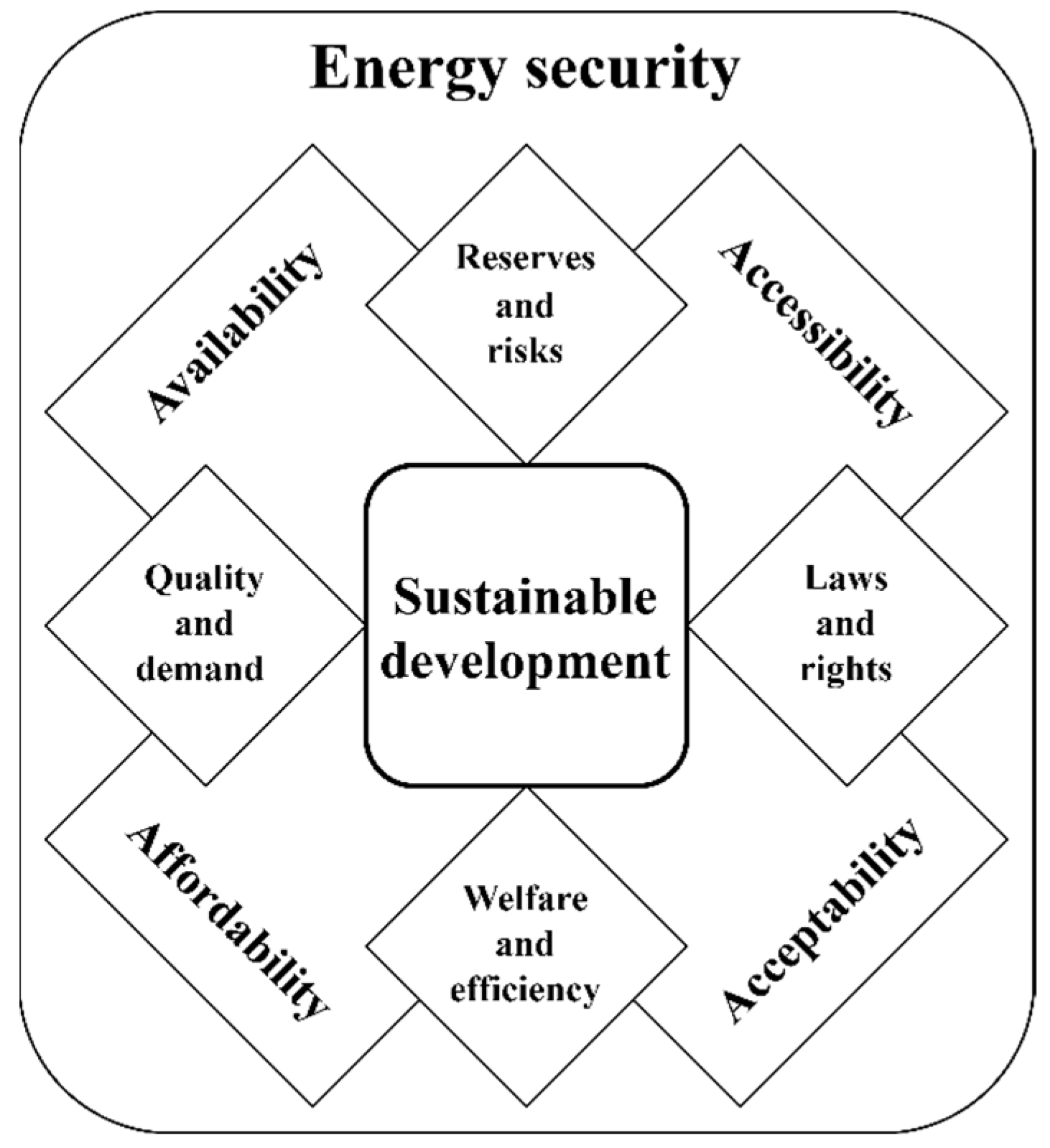
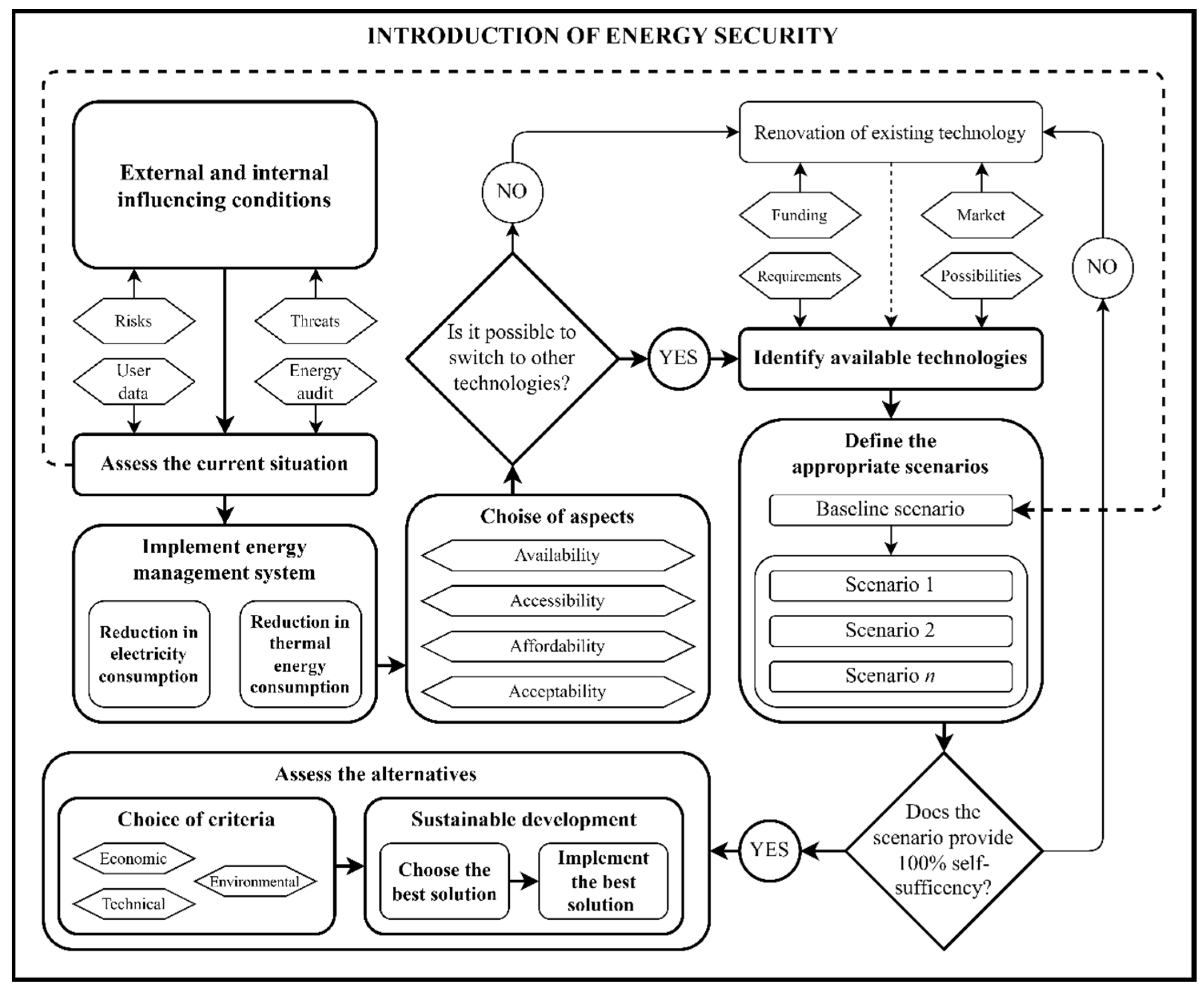
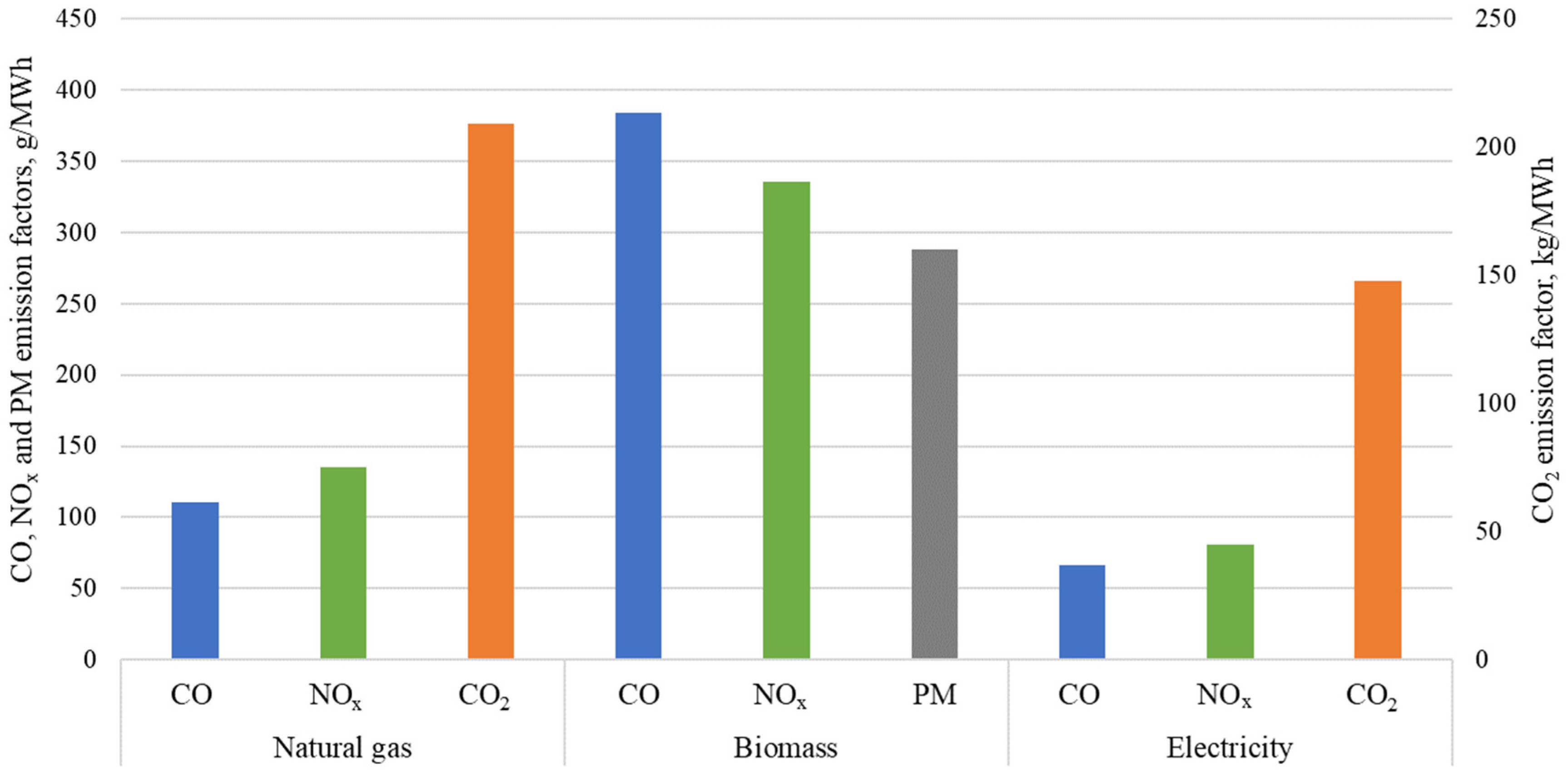
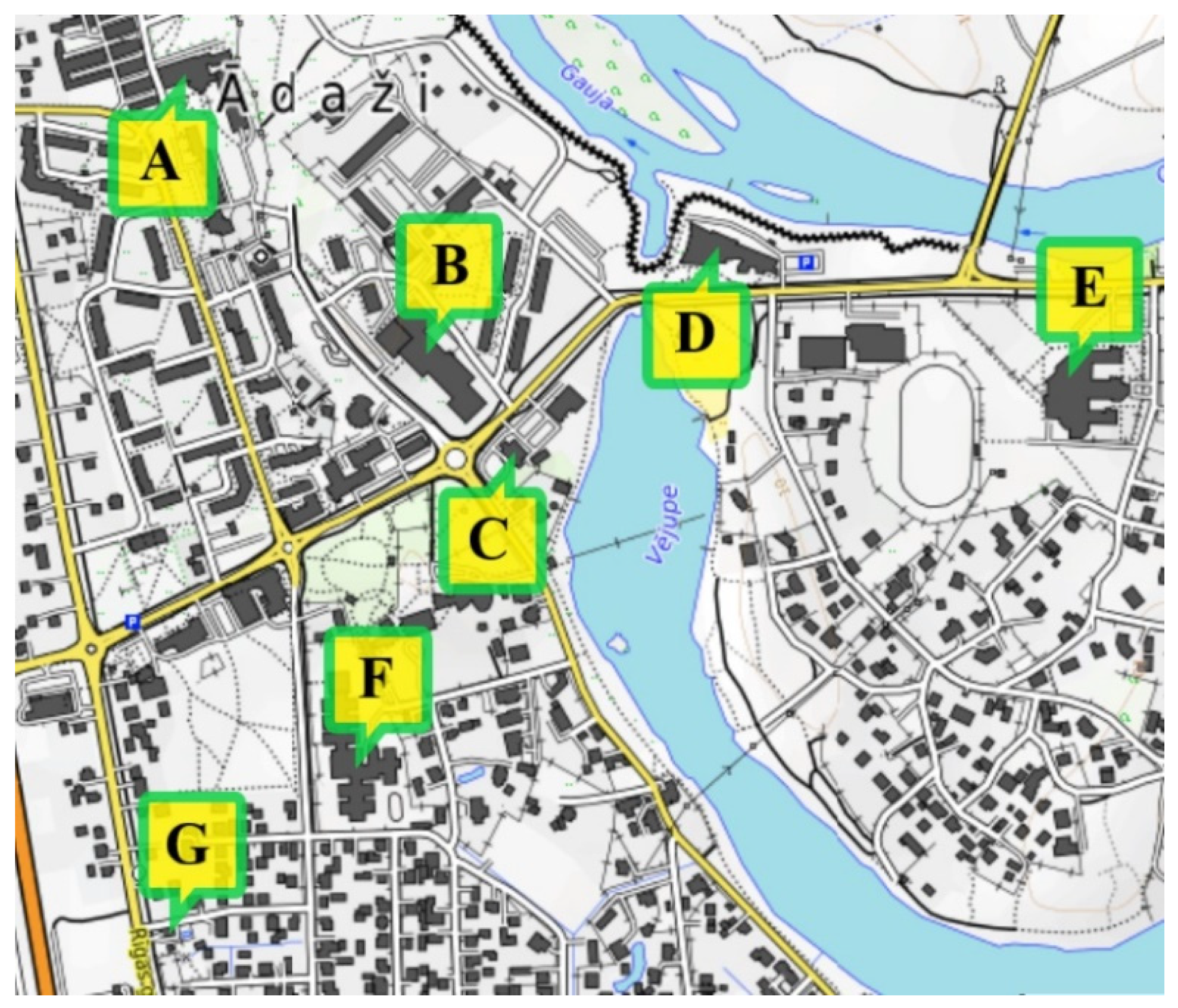
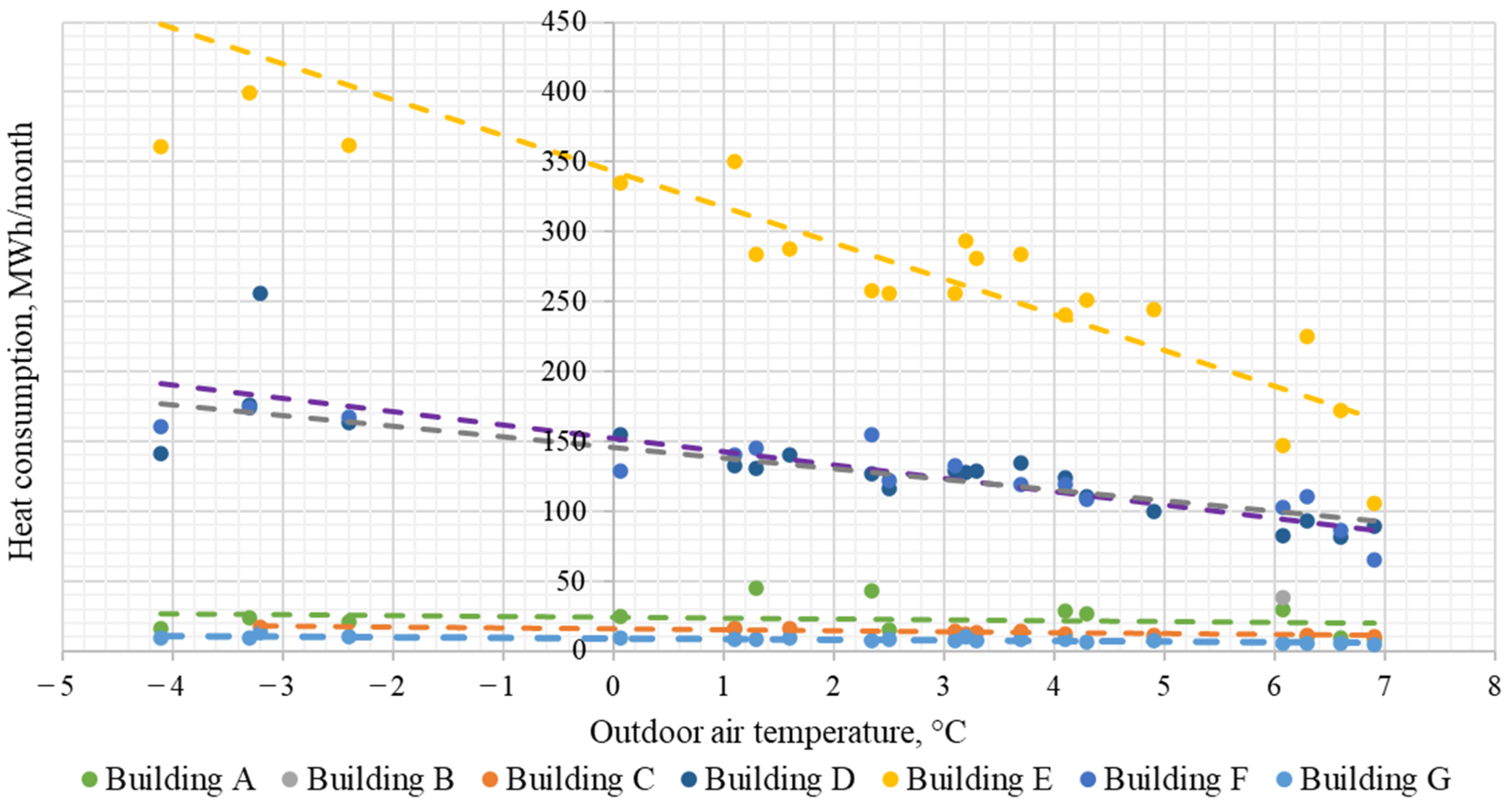
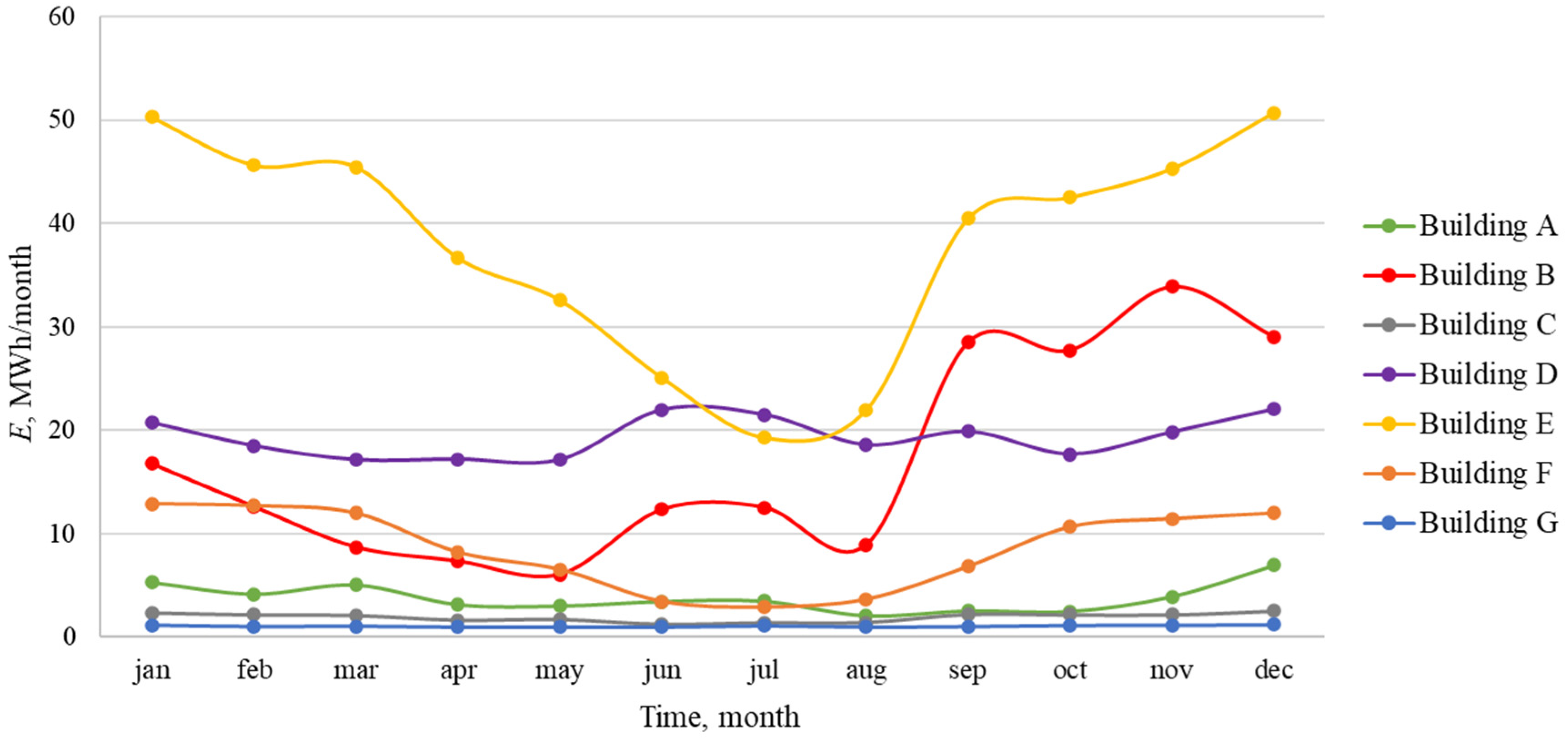
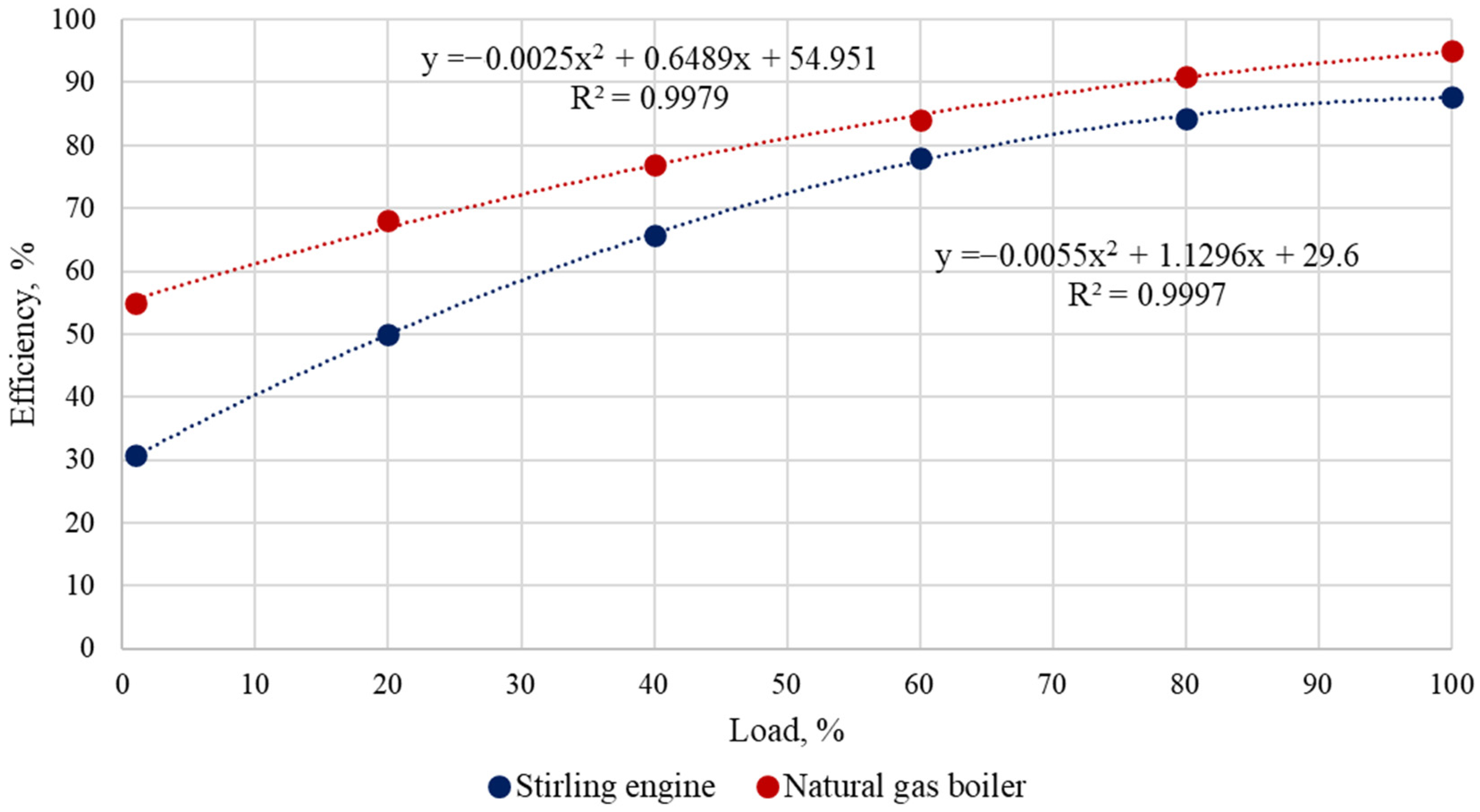
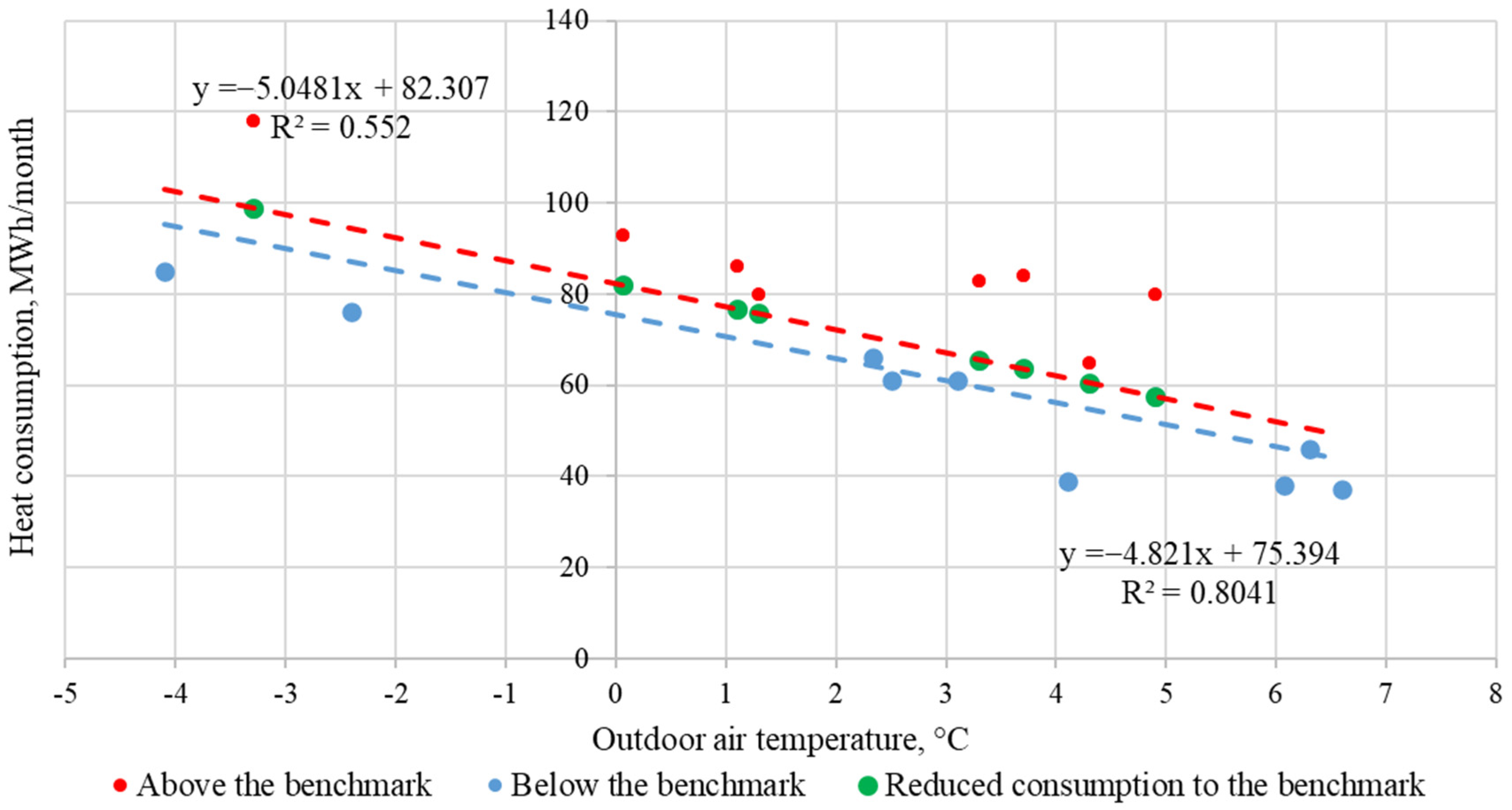
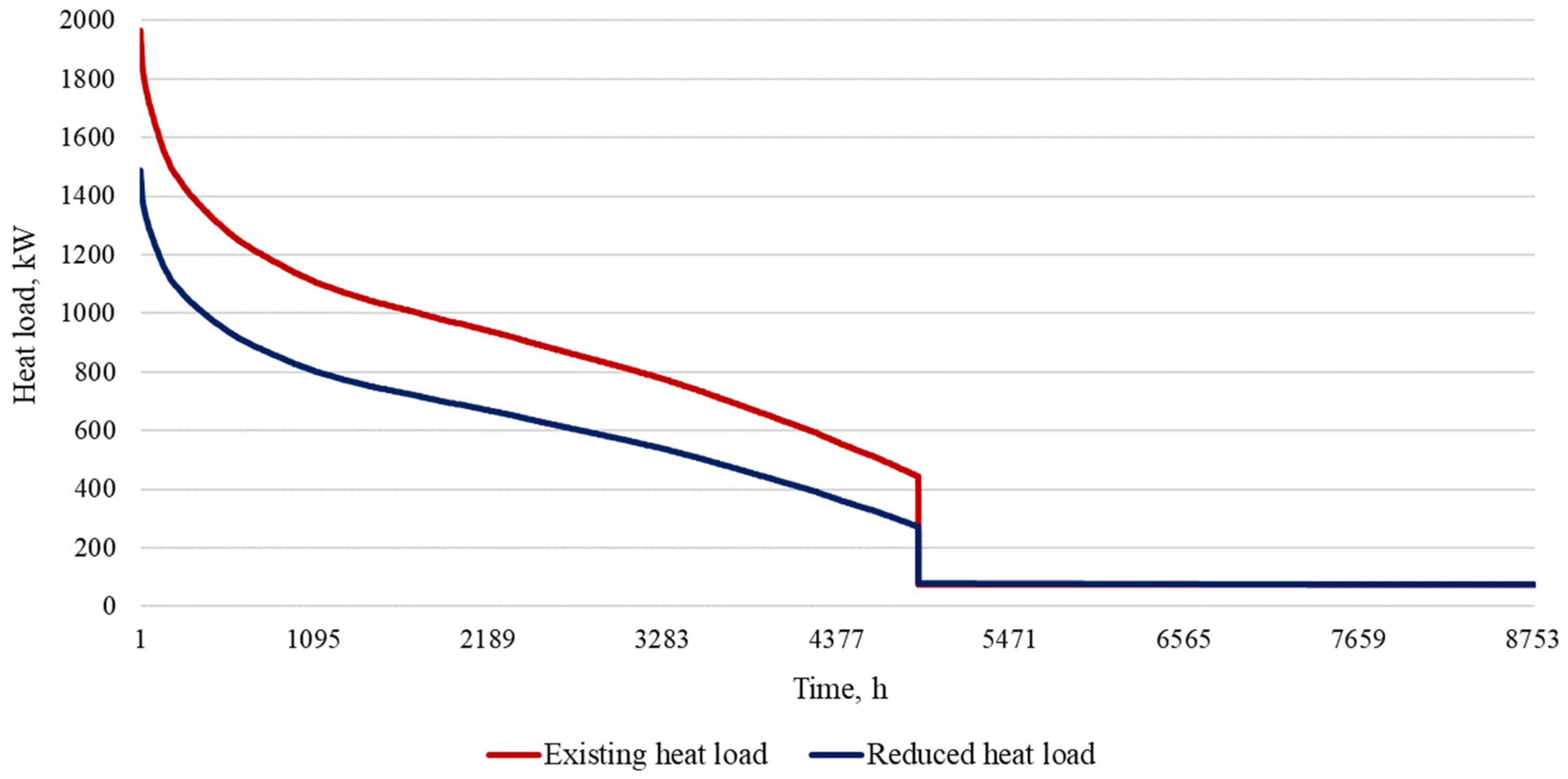
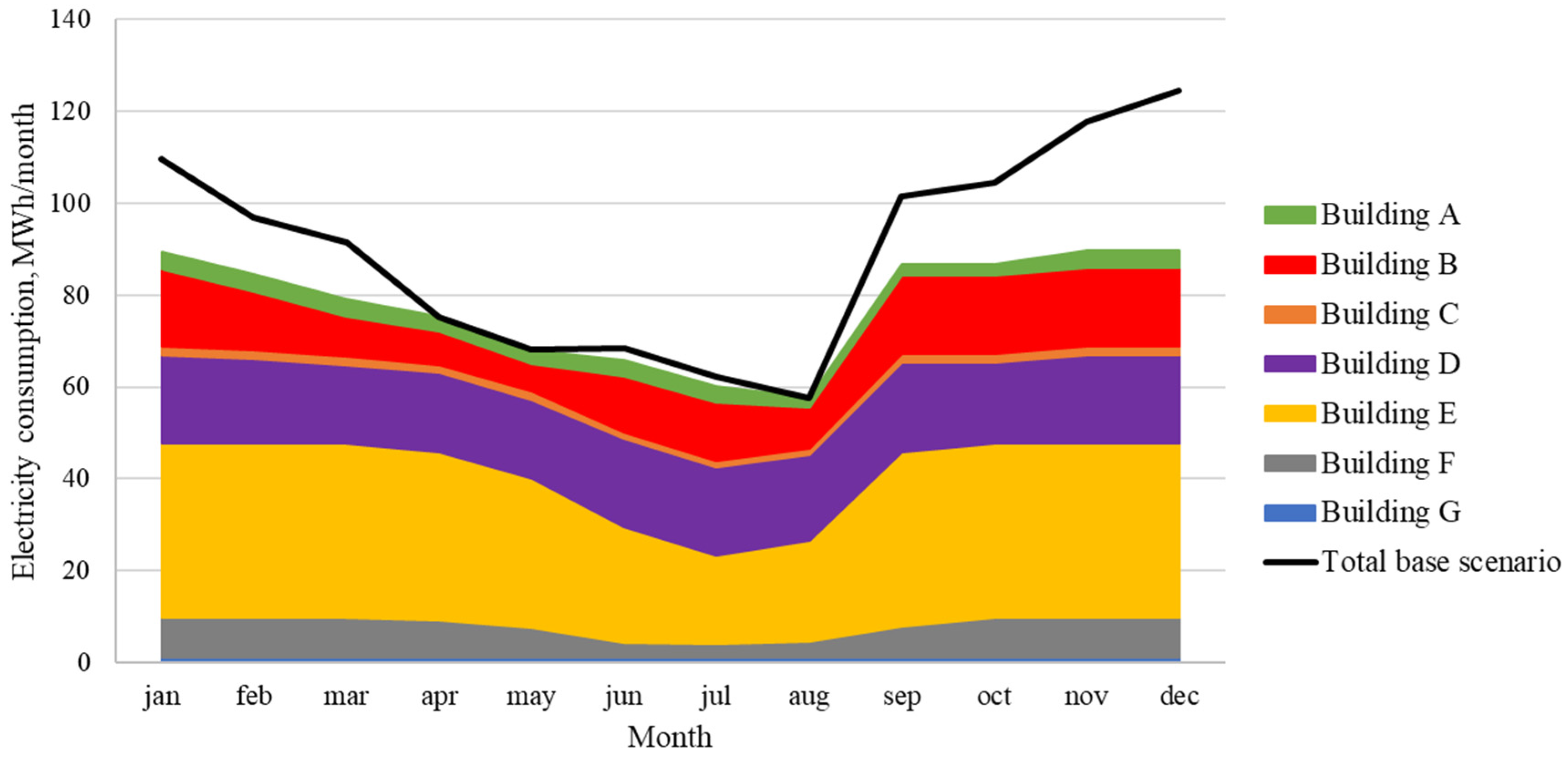
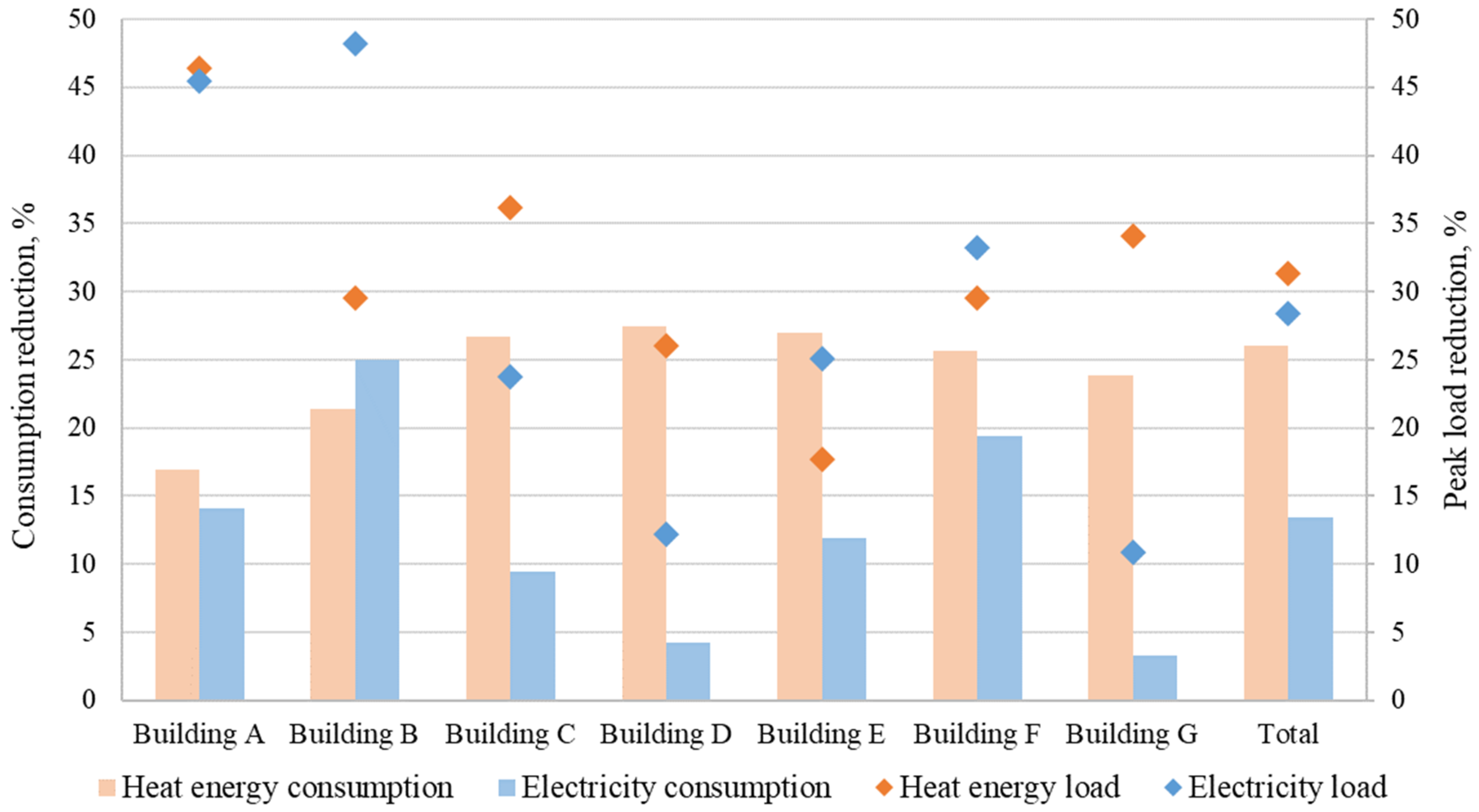
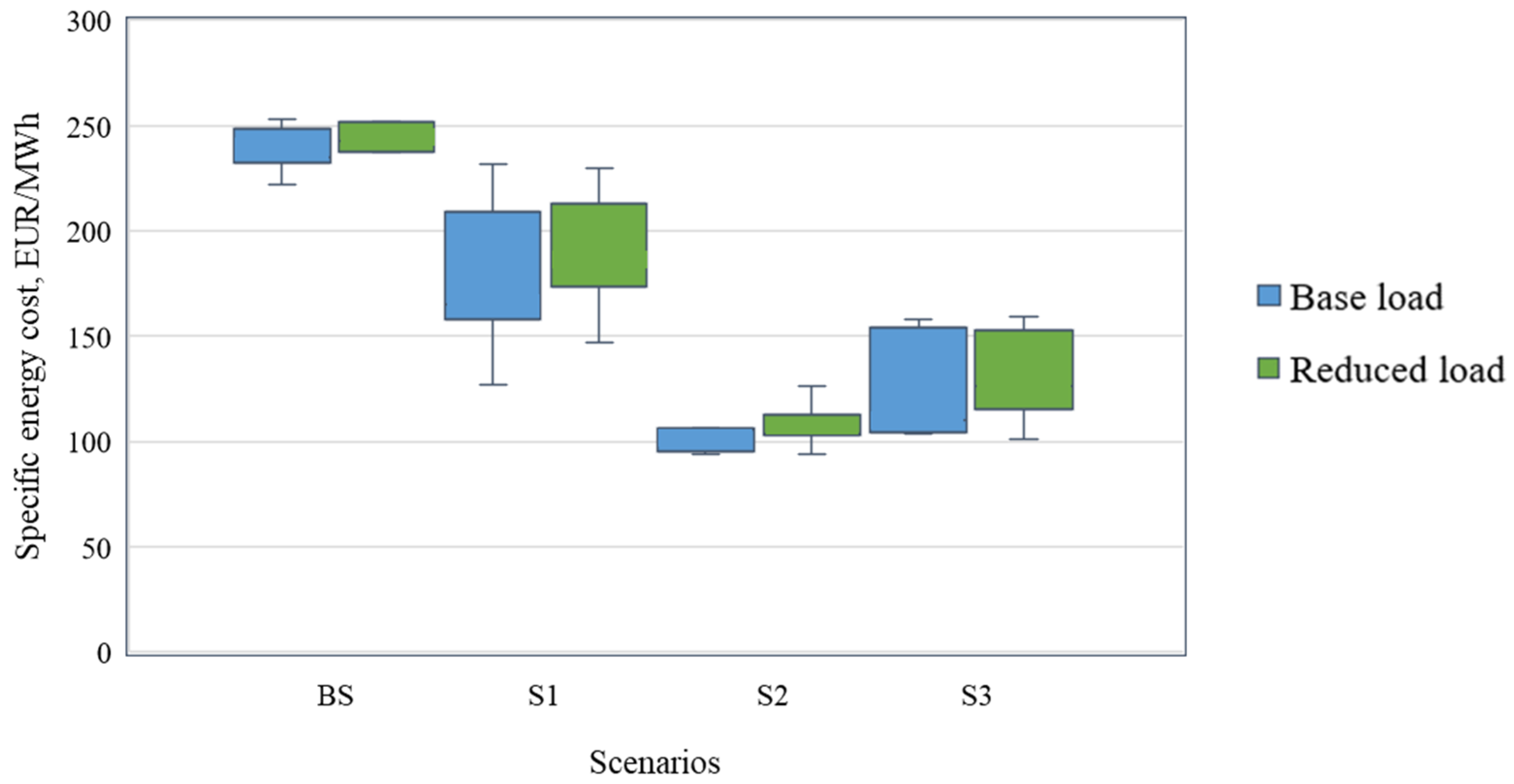
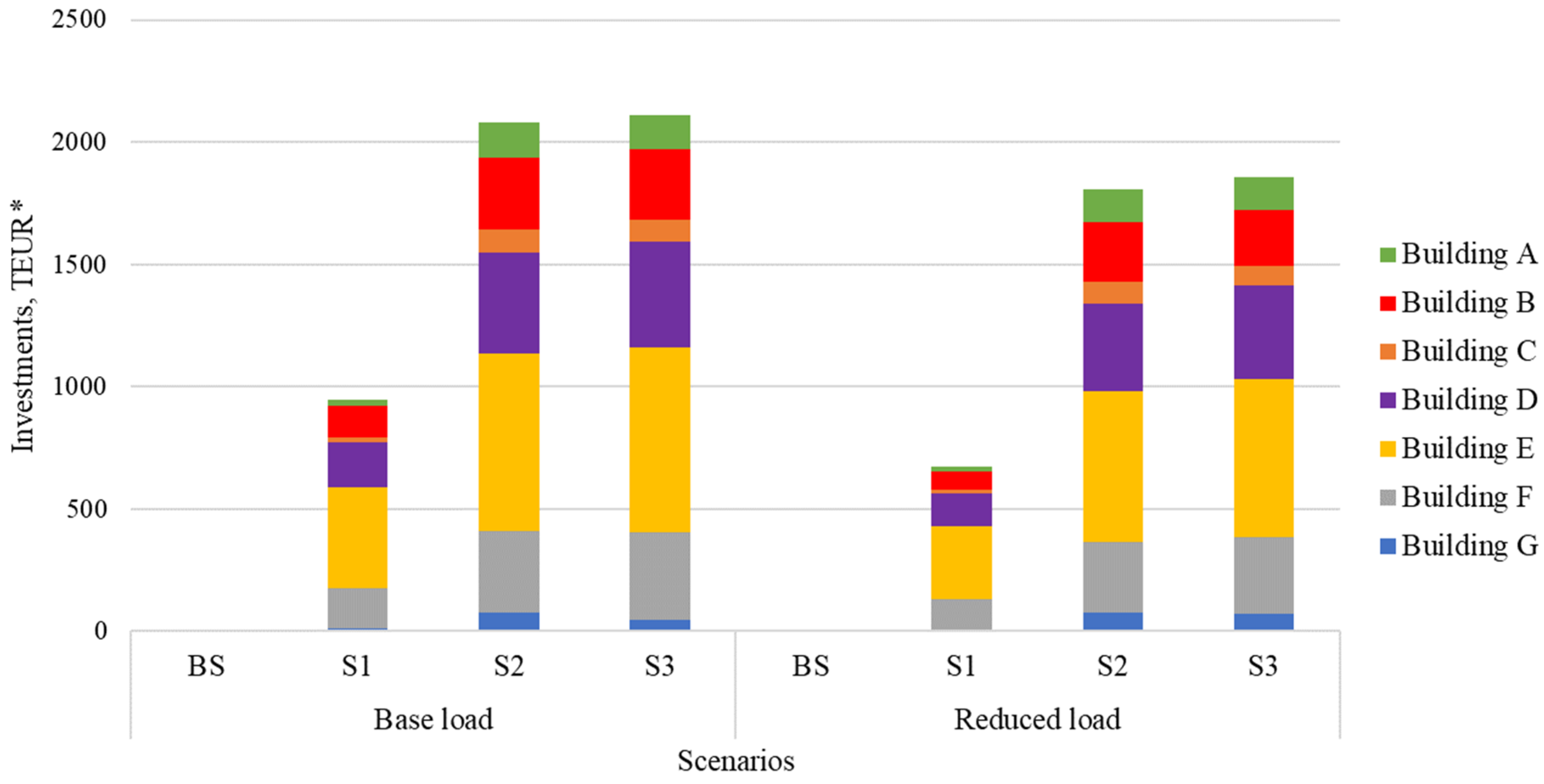
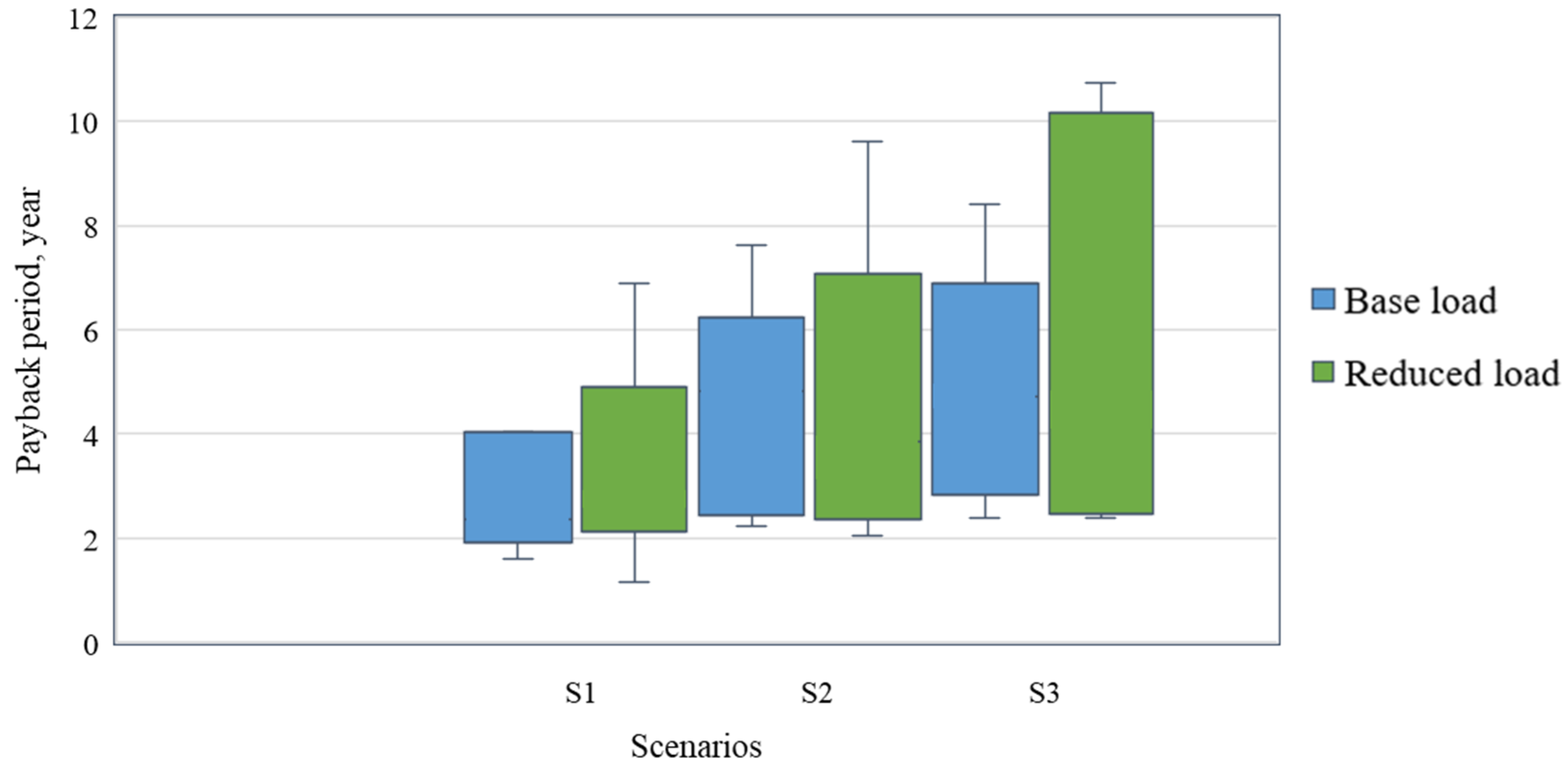
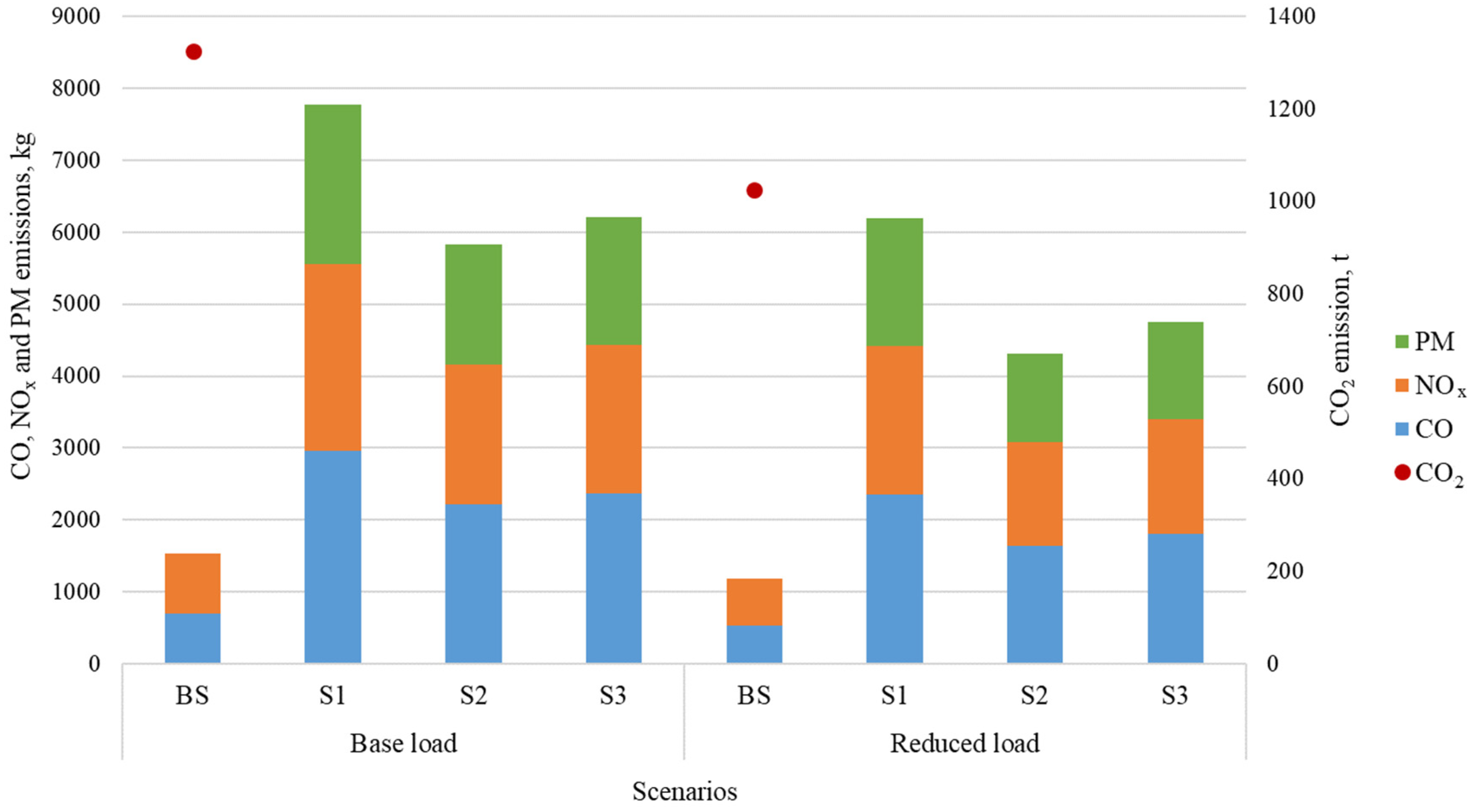
| Advantages | Disadvantages | |
|---|---|---|
| Centralised systems | Ensure that the day-ahead dispatch is technically feasible and (ideally) cost-efficient [43]; One or a few large central production facilities are much cheaper than thousands of individual installations [44]; Some heat resources can only be utilized economically in district heating (e.g., excess heat from industrial production, waste heat from electricity production, heat from waste incineration, geothermal energy) [44]; District heating is the only way to supply (existing/historical) city centres (e.g., Old City of Riga, Latvia) with large fractions of RES (renovation to zero-energy houses is not possible here) [44]. | Rural electrification (in an integrated power system, rural electrification is challenging) [45]; Some buildings are overheated or underheated due to different conditions (e.g., no energy audit was carried out) [46]; There are various limitations in electric and heat networks that prevent new users from connecting [47,48]. |
| Individual systems | Independent systems with maximal flexibility; hight sustainability level [49]; Ease of decision-making in relation to development and investment; Minimal energy losses at energy transportation to consumer. | Lack of economic scale effects [50]; Relative higher emissions to produced amount of energy; Less opportunities for receiving investments. |
| Variable | Value | Unit |
|---|---|---|
| Specific cost of Stirling engine | 750 | EUR/kW |
| Specific cost of solar PV | 25,883x0.374 | EUR/kW |
| Specific cost of heat pump | 296 | EUR/kW |
| Specific cost of solar collector | 295 | EUR/m2 |
| Specific cost of heat accumulation system | 216 | EUR/m3 |
| Efficiency solar PV | 21.1 | % |
| Solar PV loss factor | 95 | % |
| Solar collector efficiency | 77.5 | % |
| Loss factor of the solar collector system | 90 | % |
| Specific cost of natural gas | 150 | EUR/MWh |
| Additional cost for energy production from natural gas | 20.0 | % |
| Specific cost of wood pellets | 104 | EUR/MWh |
| Additional cost for energy production from wood pellets | 40.0 | % |
| Electricity tariff | 350 | EUR/MWh |
| Specific cost of electricity (sell) | 280 | EUR/MWh |
| Municipal Building | Sign | Heating Area, m2 | E (Average), MWh/Month | Q (Average), MWh/Month | Specific Annual E, kWh/m2 | Specific Annual Q, kWh/m2 | Renovation State | Available Roof Area, m2 |
|---|---|---|---|---|---|---|---|---|
| Office building | A | 333 | 3.8 | 15.6 * 1.1 ** | 131 | 328 | Partly renovated | 423 |
| Primary school | B | 8724 | 17.0 | 54.1 * 1.5 ** | 23 | 51 | New | 472 |
| Council building | C | 729 | 1.9 | 12.8 * 2.3 ** | 32 | 163 | Partly renovated | 81 |
| Cultural Centre | D | 6285 | 19.3 | 113.0 * 12.8 ** | 37 | 164 | New | 910 |
| Secondary school | E | 16,186 | 38.0 | 267.2 * 44.4 ** | 28 | 140 | Partly renovated | 1761 |
| Kinder-garten | F | 4138 | 8.6 | 109.6 * 21.6 ** | 25 | 238 | Renovated | 480 |
| Police department | G | 194 | 1.1 | 7.8 * 1.4 ** | 66 | 323 | Partly renovated | 57 |
| Energy Consumption | Scenario Name | Energy Technologies Used |
|---|---|---|
| Baseline energy consumption | Base load, BS | Natural gas boiler, electricity from the grid |
| Base load, S1 | Stirling engine | |
| Base load, S2 | Solar PV + Heat pump. Stirling engine to cover residual load | |
| Base load, S3 | Solar collectors + storage. Stirling engine to cover residual load | |
| Reduced energy consumption | Reduced load, BS | Natural gas boiler, electricity from the grid |
| Reduced load, S1 | Stirling engine | |
| Reduced load, S2 | Solar PV + Heat pump. Stirling engine to cover residual load | |
| Reduced load, S3 | Solar collectors + storage. Stirling engine to cover residual load |
| Scenarios | CO, g/MWh | NOx, g/MWh | PM, g/MWh | CO2, kg/MWh | |
|---|---|---|---|---|---|
| Base load | BS | 117 | 142 | 0 | 224 |
| S1 | 521 | 456 | 391 | 0 | |
| S2 | 378 | 331 | 283 | 0 | |
| S3 | 416 | 364 | 312 | 0 | |
| Reduced load | BS | 119 | 144 | 0 | 229 |
| S1 | 536 | 469 | 402 | 0 | |
| S2 | 362 | 317 | 271 | 0 | |
| S3 | 434 | 380 | 326 | 0 | |
Disclaimer/Publisher’s Note: The statements, opinions and data contained in all publications are solely those of the individual author(s) and contributor(s) and not of MDPI and/or the editor(s). MDPI and/or the editor(s) disclaim responsibility for any injury to people or property resulting from any ideas, methods, instructions or products referred to in the content. |
© 2024 by the authors. Licensee MDPI, Basel, Switzerland. This article is an open access article distributed under the terms and conditions of the Creative Commons Attribution (CC BY) license (https://creativecommons.org/licenses/by/4.0/).
Share and Cite
Kramens, J.; Svedovs, O.; Sturmane, A.; Vigants, E.; Kirsanovs, V.; Blumberga, D. Exploring Energy Security and Independence for Small Energy Users: A Latvian Case Study on Unleashing Stirling Engine Potential. Sustainability 2024, 16, 1224. https://doi.org/10.3390/su16031224
Kramens J, Svedovs O, Sturmane A, Vigants E, Kirsanovs V, Blumberga D. Exploring Energy Security and Independence for Small Energy Users: A Latvian Case Study on Unleashing Stirling Engine Potential. Sustainability. 2024; 16(3):1224. https://doi.org/10.3390/su16031224
Chicago/Turabian StyleKramens, Janis, Oskars Svedovs, Amanda Sturmane, Edgars Vigants, Vladimirs Kirsanovs, and Dagnija Blumberga. 2024. "Exploring Energy Security and Independence for Small Energy Users: A Latvian Case Study on Unleashing Stirling Engine Potential" Sustainability 16, no. 3: 1224. https://doi.org/10.3390/su16031224
APA StyleKramens, J., Svedovs, O., Sturmane, A., Vigants, E., Kirsanovs, V., & Blumberga, D. (2024). Exploring Energy Security and Independence for Small Energy Users: A Latvian Case Study on Unleashing Stirling Engine Potential. Sustainability, 16(3), 1224. https://doi.org/10.3390/su16031224






